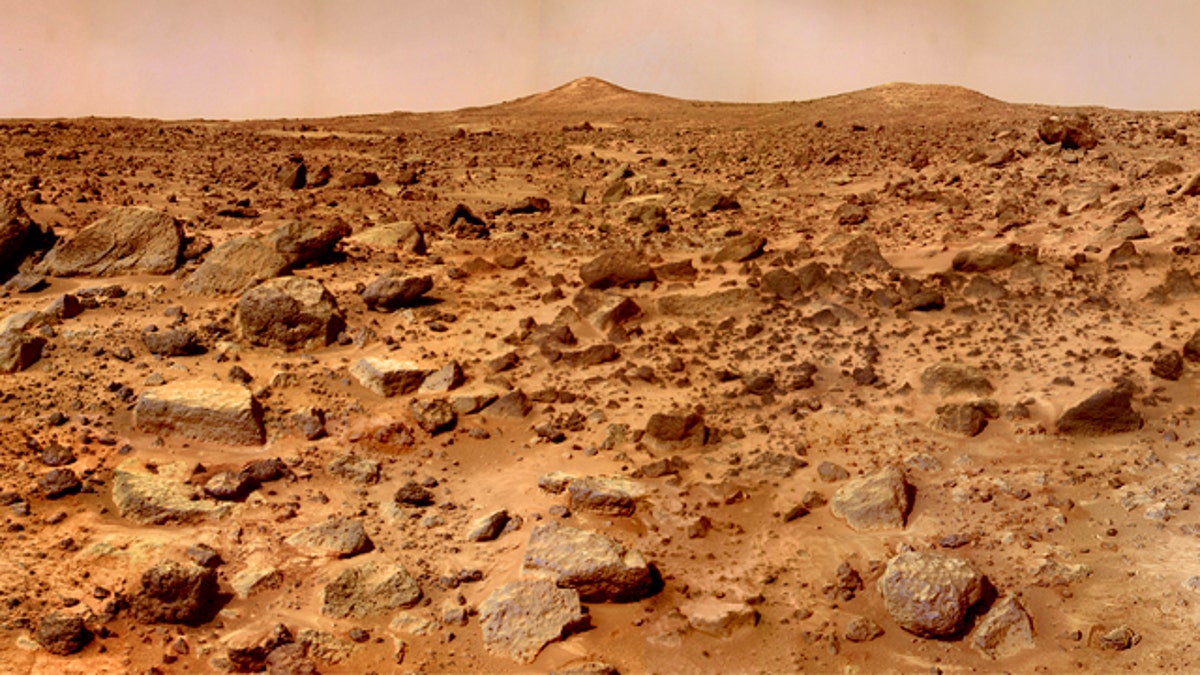
NASA's 1997 Pathfinder mission to Mars returned this stunning image of the planet's rocky red landscape. (NASA/JPL)
Ever wonder why the red planet is red?
About 180 million years ago, a planet-shattering yet naturally occurring nuclear reaction may have wiped out everything on Mars, sending a shockwave that turned the planet into dry sand.
Even more incredible: A natural nuclear reaction could have occurred on our own planet -- and could happen again, said Dr. John Brandenburg, a senior propulsion scientist at Orbital Technologies Corp.
"The Martian surface is covered with a thin layer of radioactive substances including uranium, thorium and radioactive potassium -- and this pattern radiates from a hot spot [on Mars],” Brandenburg told FoxNews.com.
“A nuclear explosion could have sent debris all around the planet," he said. "Maps of gamma rays on Mars show a big red spot that seems like a radiating debris pattern ... on the opposite side of the planet there is another red spot."
According to Brandenburg, the natural explosion, the equivalent of 1 million one-megaton hydrogen bombs, occurred in the northern Mare Acidalium region of Mars where there is a heavy concentration of radioactivity.
This explosion filled the Martian atmosphere with radio-isotopes as well, which are seen in recent gamma ray spectrometry data taken by NASA, he said.
The radioactivity also explains why the planet looks red.
Brandenburg said gamma ray spectrometry taken over the past few years shows spiking radiation from Xenon 129 -- an increase also seen on Earth after a nuclear reaction or a nuclear meltdown, including the one at Chernobyl in 1986 and the disaster in Japan earlier this month.
Dr. David Beaty, Mars program science manager at NASA’s Jet Propulsion Laboratory, told FoxNews.com that he finds the idea intriguing and fascinating. But to prove the science, the agency would need to plan a mission to explore Mare Acidalium on Mars.
And there are more pressing issues, including missions to find extraterrestrial life. “You have to assess the importance of the question relative to the cost of answering the question,” he said.
Still, Beaty expressed doubts, saying the geological conditions on this planet and Mars have existed for millennia -- what exists has existed for a long time, and there are few sudden changes. “Rocks are what they are. [A natural nuclear reaction] could happen in another billion years, but it is not something to make you want to go home to your family and move to the mountains right away,” he said.
Dr. Lars Borg, a scientist at Lawrence Livermore National Lab, called Brandenburg’s conclusions unsurprising -- and part of known geological processes, not a nuclear reaction.
"We've looked at Martian meteorites for 15 years, and looked in detail at the isotopic measurements .. and not a single person out of hundreds worrying about this have thought there could have been a nuclear explosion on Mars," he told FoxNews.com.
Brandenburg -- who once worked at Livermore himself -- defended his research, arguing that defense experts he talked to off the record said they agreed there are signs of a nuclear reaction.
Besides, there's a precedence for a natural nuclear reaction on our own planet, he noted.
The Oklo, Gabon, region of Africa has uranium-coated sediments from a nuclear reaction that occurred 2 billion years ago.
A massive nuclear explosion on Mars would have created huge craters on the surface, visible from orbiting telescopes like Hubble and from the Mars rovers. Brandenburg said such craters could have filled in with sand over the past 180 million years, leaving no visual cues to prove the theory.
Another possibility is that the reaction occurred in mid-air and did not leave a crater -- which is exactly what happened at the Tunguska event in Russia in 1909, presumably by a large comet.
Harrison Schmitt, a geological expert and the last man to step out of the Apollo spacecraft on the moon, told FoxNews.com that there is “general validity” to Brandenburg’s theory. He said the nuclear reaction may not have been caused by an explosion, however, and might have occurred over time.
Edward D. McCullough, a science and space consultant, agreed that the Mare Acidalium region of Mars does show some strange colors and terrain formations that seem unexplainable.
“There seems to be a reasonable closure between the number of fissions required to produce the Xenon 129 enhancement and the amount of energy required to toss material to that point on Mars,” he said.
“This massive nuclear explosion on Mars seems to defy natural explanation,” said Brandenburg.
